Lancia Ypsilon 2011 Owner handbook (in English)
Manufacturer: LANCIA, Model Year: 2011, Model line: Ypsilon, Model: Lancia Ypsilon 2011Pages: 299, PDF Size: 13.35 MB
Page 201 of 299
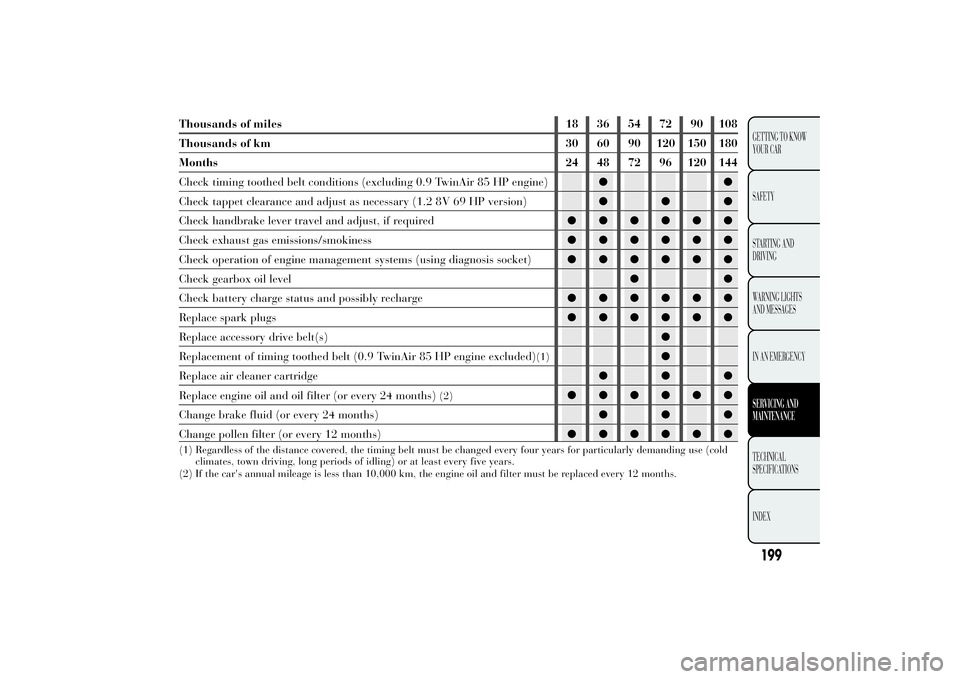
Thousands of miles 18 36 54 72 90 108
Thousands of km 30 60 90 120 150 180
Months 24 48 72 96 120 144
Check timing toothed belt conditions (excluding 0.9 TwinAir 85 HP engine)●●
Check tappet clearance and adjust as necessary (1.2 8V 69 HP version)●●●
Check handbrake lever travel and adjust, if required●●●●●●
Check exhaust gas emissions/smokiness●●●●●●
Check operation of engine management systems (using diagnosis socket)●●●●●●
Check gearbox oil level●●
Check battery charge status and possibly recharge●●●●●●
Replace spark plugs●●●●●●
Replace accessory drive belt(s)●
Replacement of timing toothed belt (0.9 TwinAir 85 HP engine excluded)
(1)
●
Replace air cleaner cartridge●●●
Replace engine oil and oil filter (or every 24 months)
(2)
●●●●●●
Change brake fluid (or every 24 months)●●●
Change pollen filter (or every 12 months)●●●●●●
(1) Regardless of the distance covered, the timing belt must be changed every four years for particularly demanding use (cold
climates, town driving, long periods of idling) or at least every five years.
(2) If the car's annual mileage is less than 10,000 km, the engine oil and filter must be replaced every 12 months.
199GETTING TO KNOW
YOUR CAR
SAFETY
STARTING AND
DRIVING
WARNING LIGHTS
AND MESSAGES
IN AN EMERGENCYSERVICING AND
MAINTENANCETECHNICAL
SPECIFICA
TIONS
INDEX
Page 202 of 299
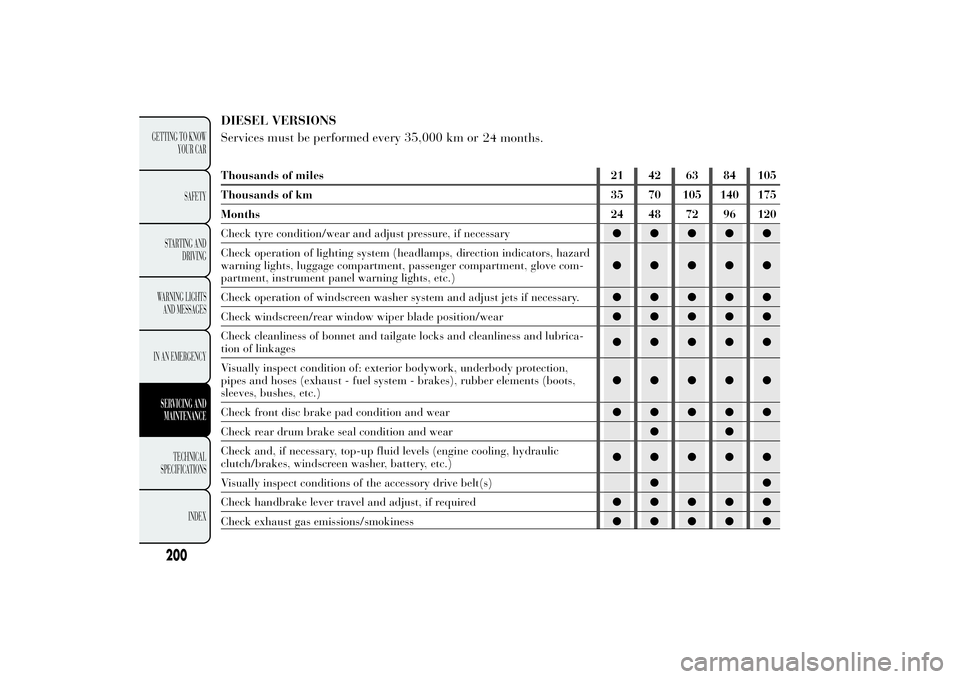
DIESEL VERSIONS
Services must be performed every 35,000 km or
24 months.Thousands of miles 21 42 63 84 105
Thousands of km 35 70 105 140 175
Months 24 48 72 96 120
Check tyre condition/wear and adjust pressure, if necessary●●●●●
Check operation of lighting system (headlamps, direction indicators, hazard
warning lights, luggage compartment, passenger compartment, glove com-
partment, instrument panel warning lights, etc.)●●●●●
Check operation of windscreen washer system and adjust jets if necessary.●●●●●
Check windscreen/rear window wiper blade position/wear●●●●●
Check cleanliness of bonnet and tailgate locks and cleanliness and lubrica-
tion of linkages●●●●●
Visually inspect condition of: exterior bodywork, underbody protection,
pipes and hoses (exhaust - fuel system - brakes), rubber elements (boots,
sleeves, bushes, etc.)●●●●●
Check front disc brake pad condition and wear●●●●●
Check rear drum brake seal condition and wear●●
Check and, if necessary, top-up fluid levels (engine cooling, hydraulic
clutch/brakes, windscreen washer, battery, etc.)●●●●●
Visually inspect conditions of the accessory drive belt(s)●●
Check handbrake lever travel and adjust, if required●●●●●
Check exhaust gas emissions/smokiness●●●●●
200
GETTING TO KNOW
YOUR CAR
SAFETY
STARTING AND
DRIVING
WARNING LIGHTS
AND MESSAGES
IN AN EMERGENCYSERVICING AND
MAINTENANCE
TECHNICAL
SPECIFICA
TIONS
INDEX
Page 203 of 299
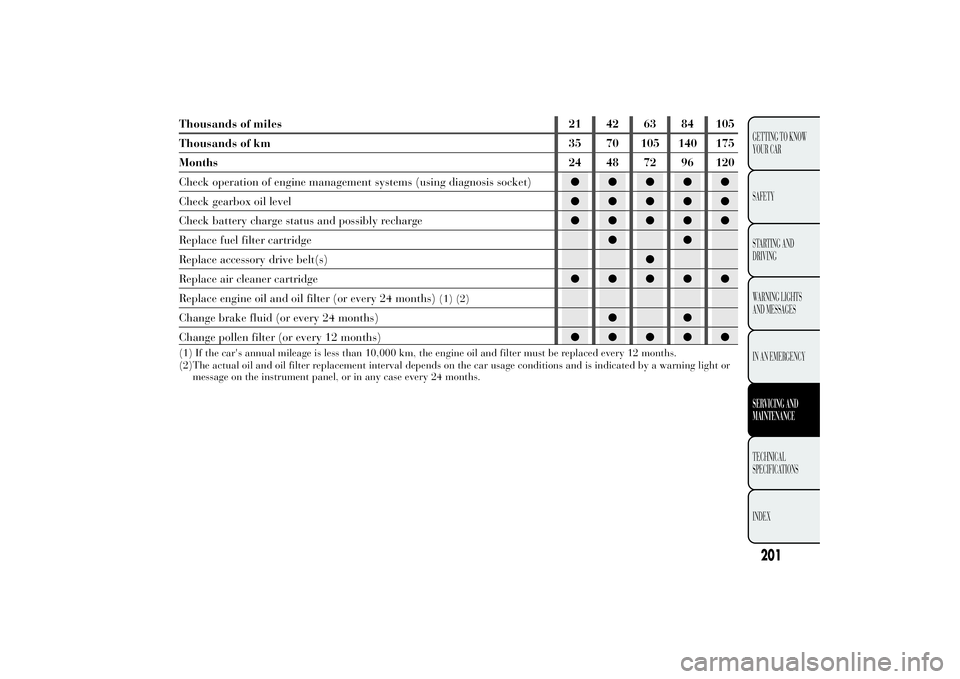
Thousands of miles 21 42 63 84 105
Thousands of km 35 70 105 140 175
Months 24 48 72 96 120
Check operation of engine management systems (using diagnosis socket)●●●●●
Check gearbox oil level●●●●●
Check battery charge status and possibly recharge●●●●●
Replace fuel filter cartridge●●
Replace accessory drive belt(s)●
Replace air cleaner cartridge●●●●●
Replace engine oil and oil filter (or every 24 months)
(1) (2)
Change brake fluid (or every 24 months)●●
Change pollen filter (or every 12 months)●●●●●(1) If the car's annual mileage is less than 10,000 km, the engine oil and filter must be replaced every 12 months.
(2)The actual oil and oil filter replacement interval depends on the car usage conditions and is indicated by a warning light or
message on the instrument panel, or in any case every 24 months.
201GETTING TO KNOW
YOUR CAR
SAFETY
STARTING AND
DRIVING
WARNING LIGHTS
AND MESSAGES
IN AN EMERGENCYSERVICING AND
MAINTENANCETECHNICAL
SPECIFICA
TIONS
INDEX
Page 204 of 299
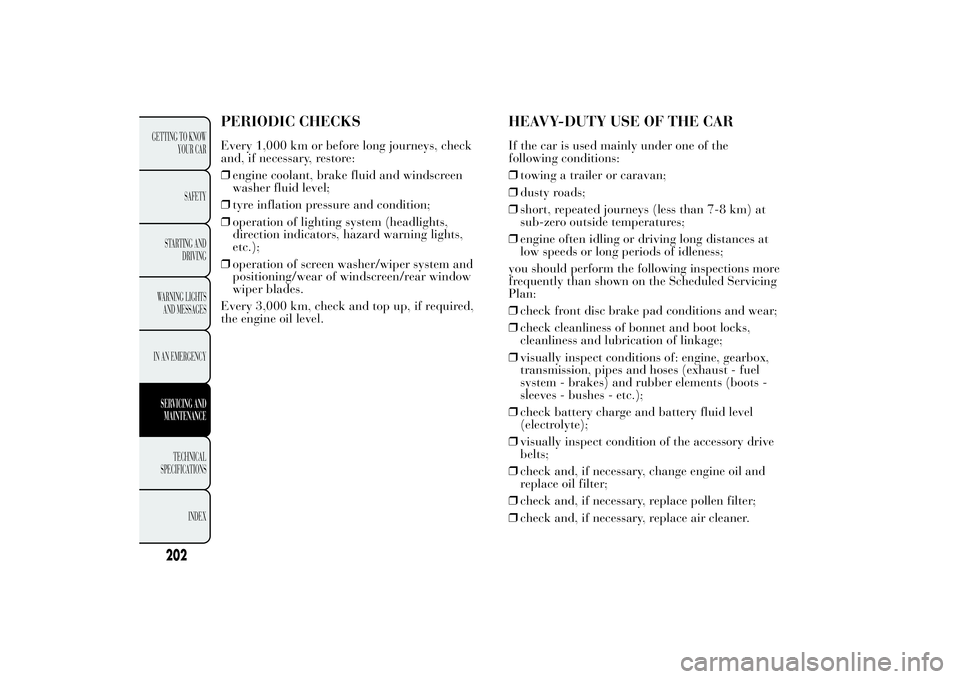
PERIODIC CHECKSEvery 1,000 km or before long journeys, check
and, if necessary, restore:
❒engine coolant, brake fluid and windscreen
washer fluid level;
❒tyre inflation pressure and condition;
❒operation of lighting system (headlights,
direction indicators, hazard warning lights,
etc.);
❒operation of screen washer/wiper system and
positioning/wear of windscreen/rear window
wiper blades.
Every 3,000 km, check and top up, if required,
the engine oil level.
HEAVY-DUTY USE OF THE CARIf the car is used mainly under one of the
following conditions:
❒towing a trailer or caravan;
❒dusty roads;
❒short, repeated journeys (less than 7-8 km) at
sub-zero outside temperatures;
❒engine often idling or driving long distances at
low speeds or long periods of idleness;
you should perform the following inspections more
frequently than shown on the Scheduled Servicing
Plan:
❒check front disc brake pad conditions and wear;
❒check cleanliness of bonnet and boot locks,
cleanliness and lubrication of linkage;
❒visually inspect conditions of: engine, gearbox,
transmission, pipes and hoses (exhaust - fuel
system - brakes) and rubber elements (boots -
sleeves - bushes - etc.);
❒check battery charge and battery fluid level
(electrolyte);
❒visually inspect condition of the accessory drive
belts;
❒check and, if necessary, change engine oil and
replace oil filter;
❒check and, if necessary, replace pollen filter;
❒check and, if necessary, replace air cleaner.
202
GETTING TO KNOW
YOUR CAR
SAFETY
STARTING AND
DRIVING
WARNING LIGHTS
AND MESSAGES
IN AN EMERGENCYSERVICING AND
MAINTENANCE
TECHNICAL
SPECIFICA
TIONS
INDEX
Page 205 of 299

CHECKING FLUID LEVELS
WARNING
Never smoke while working in the
engine compartment: gas
and
inflammable vapours may be present, with
the risk of fire.
WARNING
Be very careful when working in the
engine compartment when
the engine
is hot: you may get burned. Remember that
the fan may start up if the engine is hot:
this could injure you. Scarves, ties and other
loose clothing might be pulled by moving
parts.
Be careful, when topping up, and take
care not to mix up the various types
of fluids: they are all incompatible with
one another and could seriously damage the
car.
203GETTING TO KNOW
YOUR CAR
SAFETY
STARTING AND
DRIVING
WARNING LIGHTS
AND MESSAGES
IN AN EMERGENCYSERVICING AND
MAINTENANCETECHNICAL
SPECIFICA
TIONS
INDEX
Page 206 of 299

0.9 TwinAir 85 HP versionsA. Engine oil plug/filler B. Engine oil dipstick C. Engine coolant D. Washer fluid for windscreen/rear window
E. Brake fluid F. Battery
F
E
CD
B
A
fig. 158
L0F0089
204
GETTING TO KNOW
YOUR CAR
SAFETY
STARTING AND
DRIVING
WARNING LIGHTS
AND MESSAGES
IN AN EMERGENCYSERVICING AND
MAINTENANCE
TECHNICAL
SPECIFICA
TIONS
INDEX
Page 207 of 299

1.2 8V 69 HP versionsA. Engine oil dipstick B. Engine oil plug/filler C. Engine coolant D. Washer fluid for windscreen/rear window
E. Brake fluid F. Batteryfig. 159
L0F0050
205GETTING TO KNOW
YOUR CAR
SAFETY
STARTING AND
DRIVING
WARNING LIGHTS
AND MESSAGES
IN AN EMERGENCYSERVICING AND
MAINTENANCETECHNICAL
SPECIFICA
TIONS
INDEX
Page 208 of 299

1.3 16V MultiJet versionsA. Engine oil dipstick B. Engine oil plug/filler C. Engine coolant D. Washer fluid for windscreen/rear window
E. Brake fluid F. Battery
E
A
CD
B
F
fig. 160
L0F0090
206
GETTING TO KNOW
YOUR CAR
SAFETY
STARTING AND
DRIVING
WARNING LIGHTS
AND MESSAGES
IN AN EMERGENCYSERVICING AND
MAINTENANCE
TECHNICAL
SPECIFICA
TIONS
INDEX
Page 209 of 299
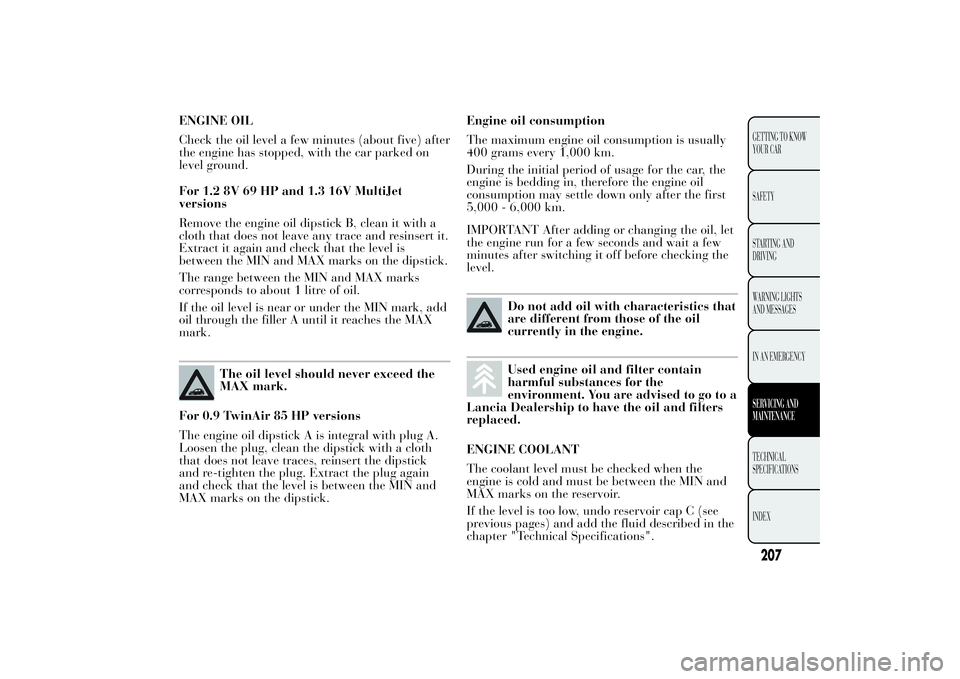
ENGINE OIL
Check the oil level a few minutes (about five) after
the engine has stopped, with the car parked on
level ground.
For 1.2 8V 69 HP and 1.3 16V MultiJet
versions
Remove the engine oil dipstick B, clean it with a
cloth that does not leave any trace and resinsert it.
Extract it again and check that the level is
between the MIN and MAX marks on the dipstick.
The range between the MIN and MAX marks
corresponds to about 1 litre of oil.
If the oil level is near or under the MIN mark, add
oil through the filler A until it reaches the MAX
mark.
The oil level should never exceed the
MAX mark.
For 0.9 TwinAir 85 HP versions
The engine oil dipstick A is integral with plug A.
Loosen the plug, clean the dipstick with a cloth
that does not leave traces, reinsert the dipstick
and re-tighten the plug. Extract the plug again
and check that the level is between the MIN and
MAX marks on the dipstick.Engine oil consumption
The maximum engine oil consumption is usually
400 grams every 1,000 km.
During the initial period of usage for the car, the
engine is bedding in, therefore the engine oil
consumption may settle down only after the first
5,000 - 6,000 km.
IMPORTANT After adding or changing the oil, let
the engine run for a few seconds and wait a few
minutes after switching it off before checking the
level.
Do not add oil with characteristics that
are different from those of the oil
currently in the engine.Used engine oil and filter contain
harmful substances for the
environment. You are advised to go to a
Lancia Dealership to have the oil and filters
replaced.
ENGINE COOLANT
The coolant level must be checked when the
engine is cold and must be between the MIN and
MAX marks on the reservoir.
If the level is too low, undo reservoir cap C (see
previous pages) and add the fluid described in the
chapter "Technical Specifications".
207GETTING TO KNOW
YOUR CAR
SAFETY
STARTING AND
DRIVING
WARNING LIGHTS
AND MESSAGES
IN AN EMERGENCYSERVICING AND
MAINTENANCETECHNICAL
SPECIFICA
TIONS
INDEX
Page 210 of 299

PARAFLU
UP
anti-freeze is used in the
engine cooling system. Use the same
fluid as in the cooling system when
topping up. PARAFLU
UP
may not be mixed
with any other types of fluids. If this occurs,
do not start the engine and contact your
Lancia Dealership immediately.
WARNING
The cooling system is pressurised. If
necessary, only
replace the cap with
another genuine one or the operation of the
system may be adversely affected. Do not
remove the reservoir cap when the engine is
hot: you risk scalding yourself.
WINDSCREEN/REAR WINDOW WASHING
FLUID
If the level is too low, raise reservoir cap D (see
previous pages) and add the fluid described in the
chapter "Technical Specifications".
WARNING
Do not travel if the windscreen
washer reservoir is
empty: using the
windscreen washer is essential for
improving visibility. Some commercial
windscreen washer additives are flammable.
The engine compartment contains hot
components which may set it on fire.
BRAKE FLUID
Check that the liquid is at the maximum level (the
fluid level in the reservoir must not exceed the
MAX mark). If the fluid level in the tank is too
low, undo reservoir cap E (see previous pages) and
add the fluid described in the chapter "Technical
Specifications".
NoteCarefully clean the cap of the reservoir E
and the surrounding surface.
When opening the cap, make sure that no dirt gets
into the reservoir.
For topping-up, always use a funnel with
integrated filter with mesh equal to or lower than
0.12 mm.
IMPORTANT Brake fluid is hygroscopic (i.e. it
absorbs moisture). For this reason, if the car
is mainly used in areas with a high degree
of atmospheric humidity, the fluid should be
replaced at more frequent intervals than specified
in the “Scheduled Servicing Plan”.
208
GETTING TO KNOW
YOUR CAR
SAFETY
STARTING AND
DRIVING
WARNING LIGHTS
AND MESSAGES
IN AN EMERGENCYSERVICING AND
MAINTENANCE
TECHNICAL
SPECIFICA
TIONS
INDEX